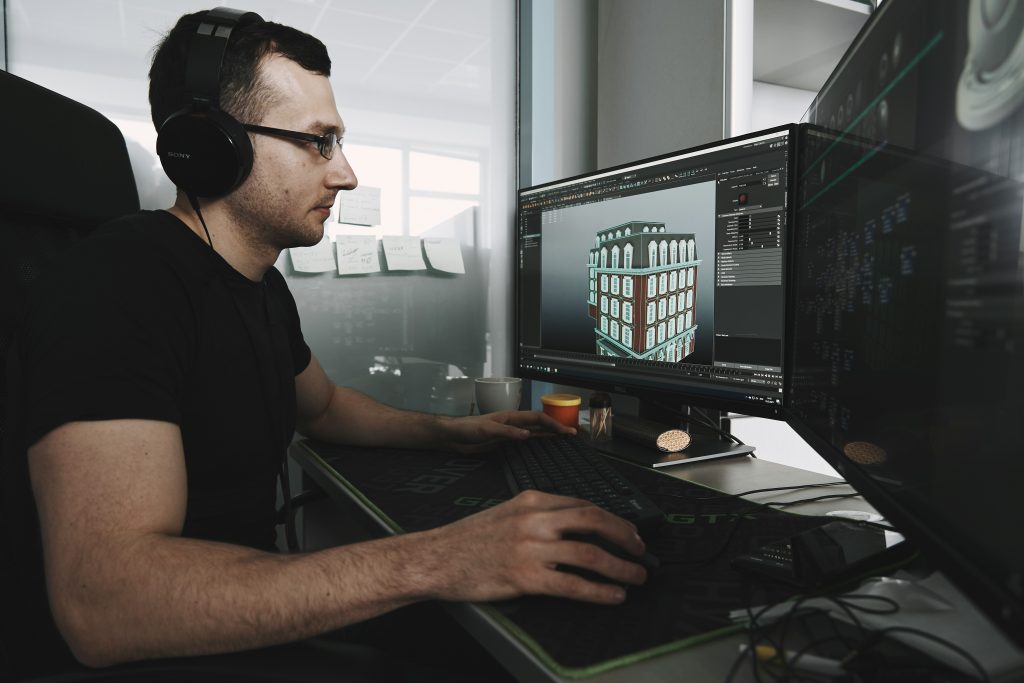
09 Mar Interactive Online Art Galleries in 2024
Interactive online art galleries are revolutionizing the way we experience and appreciate creativity. Unlike traditional virtual tours, these platforms invite viewers to actively engage with art, fostering a deeper connection and understanding. By transcending static displays, they offer accessibility, engagement, and immersion to a diverse global audience, propelling art appreciation into a dynamic digital era. This digital evolution empowers artists to explore new avenues of expression while providing viewers with unprecedented opportunities for discovery and interpretation. As the boundaries of artistic expression expand, interactive online galleries serve as a vibrant nexus where creativity thrives and traditional norms are redefined. Together, artists, viewers, and the evolving landscape of art embark on a transformative journey, embracing the endless possibilities of the digital canvas.
Types of Interactive Art Galleries

Photo by UNIBOA
3D Virtual Galleries
Step into a mesmerizing virtual realm that meticulously replicates the ambiance and aesthetics of a traditional physical gallery. With advanced technology, these galleries create an immersive experience, transporting visitors to a realm where art comes to life. Through stunning visual and auditory elements, they offer a rich and realistic environment for exploration, allowing viewers to appreciate art from the comfort of their own space.
Augmented Reality Galleries
Blurring the boundaries between the digital and physical worlds, augmented reality galleries revolutionize the art-viewing experience. By overlaying digital artworks onto real-world environments using AR technology, these galleries offer a unique fusion of the tangible and the digital. As visitors navigate through physical spaces, they encounter digital artworks seamlessly integrated into their surroundings, creating an interactive and dynamic encounter with art.
Interactive Installations
At the forefront of artistic innovation, interactive installations redefine the relationship between the viewer and the artwork. These galleries empower visitors to engage directly with the art, inviting them to manipulate or influence the pieces through various interactive mechanisms. By blurring the lines between creator and observer, interactive installations foster a deeper connection and understanding of the artistic process, encouraging viewers to become active participants in the creation of meaning and interpretation.
Curated Online Exhibitions
In the digital age, curated online exhibitions serve as a gateway to a world of art accessible to anyone with an internet connection. These exhibitions curate a diverse selection of artworks, presented alongside multimedia content and storytelling elements that enrich the viewer’s understanding and appreciation. By contextualizing artworks within broader narratives, curated online exhibitions provide a cohesive and engaging experience that transcends traditional gallery spaces, inviting viewers to explore and discover art from diverse perspectives.
Social Art Platforms
In the age of connectivity, social art platforms are dynamic centers of community and creation. These platforms give art lovers a place to interact, work together, and have deep conversations about art. Social art platforms democratize the art world by encouraging a feeling of community and shared experiences, which makes it more approachable and welcoming to people from all backgrounds. Users on these sites create lifelong friendships and add to a vibrant international community of art enthusiasts via common interests and passions.
Creating an Interactive Online Art Gallery

Photo by Maxim Tolchinskiy
Platform Selection
Choosing the right platform for your online gallery is a critical decision that can significantly impact its success. Factors such as features, budget, and the overall experience you aim to provide should be carefully considered. Each platform offers different capabilities and functionalities, so it’s essential to assess which one aligns best with your goals and resources. Whether you prioritize customization options, scalability, or user interface simplicity, selecting the right platform lays the foundation for a successful virtual gallery.
Curation and Storytelling
The curation of artworks, the development of themes, and the crafting of engaging narratives are essential elements that contribute to the overall immersive experience of your online gallery. Thoughtful selection of art pieces that complement each other, building coherent themes that resonate with your audience, and weaving compelling stories around the exhibited works can captivate visitors and leave a lasting impression. Effective curation and storytelling elevate the gallery beyond a mere collection of artworks, transforming it into a cohesive and memorable artistic journey.
Technical Considerations
Attention to technical details is crucial for creating a seamless and captivating online gallery experience. From 3D modeling to AR development and interactivity design, various technical aspects must be carefully executed to ensure optimal performance and user engagement. High-quality visuals, smooth navigation, and interactive features enhance the immersive nature of the gallery, allowing visitors to explore and interact with the artworks in meaningful ways. Investing time and resources into technical considerations enables you to deliver a polished and immersive online gallery that resonates with your audience.
Accessibility and User Experience
Ensuring ease of navigation and inclusivity are key aspects of enhancing the accessibility and user experience of your online gallery. Implementing intuitive navigation features, providing alternative formats for content consumption, and optimizing for different devices and screen sizes contribute to a seamless browsing experience for all visitors. Moreover, prioritizing inclusivity by adhering to accessibility standards ensures that your gallery is welcoming to a diverse audience, including those with disabilities. By focusing on accessibility and user experience, you create an environment where everyone can fully engage with and appreciate the artistic content showcased in your virtual gallery.
Promoting Interactive Art Galleries

Photo by Georgia de Lotz
Social Media Marketing
In today’s digital age, social media marketing is a cornerstone for any art gallery seeking to expand its presence and connect with audiences worldwide. Platforms such as Instagram, Facebook, and X (formerly known as Twitter) offer invaluable opportunities to showcase snippets of your gallery’s collection, share behind-the-scenes content, and engage directly with your audience. Through visually captivating posts and interactive storytelling, you can create a dynamic online presence that not only showcases your artwork but also invites viewers into the creative process.
Collaborations with Influencers
Influencer collaborations have emerged as a powerful strategy for art galleries to extend their reach and credibility within the art world. By partnering with artists, art critics, and influential online communities, galleries can tap into existing networks and leverage their expertise to amplify their brand message. These collaborations not only introduce your gallery to new audiences but also lend it credibility and authority within the artistic community, establishing valuable connections that can drive long-term growth.
Online Advertising
In the competitive landscape of the digital art scene, targeted online advertising campaigns are essential for ensuring that your interactive gallery stands out amidst the noise. By strategically placing ads on relevant websites and social media platforms, you can effectively reach your target audience and drive traffic to your virtual gallery. From eye-catching display ads to engaging sponsored content, online advertising offers a versatile toolkit for promoting your gallery and attracting visitors who are passionate about art and culture.
Press Outreach
Securing media coverage in both online and offline publications is a fundamental component of any comprehensive marketing strategy for art galleries. By generating buzz and publicity around your gallery’s exhibitions, events, and initiatives, press outreach helps to broaden your reach and attract diverse audiences. Whether through feature articles, reviews, or interviews with gallery curators and artists, media exposure enhances your gallery’s visibility and positions it as a cultural destination worthy of attention.
Virtual Events and Tours
In the era of social distancing and remote engagement, virtual events and tours have emerged as innovative ways for art galleries to connect with their audiences and foster a sense of community. From live presentations and virtual exhibitions to interactive Q&A sessions and guided tours, these digital experiences offer viewers an immersive glimpse into the world of art from the comfort of their own homes. By leveraging technology to create engaging and accessible content, galleries can cultivate meaningful relationships with their audience members and spark conversations that transcend physical boundaries.

Photo by Erik Mclean
Conclusion
The evolution of interactive online art galleries represents a transformative era in art appreciation. Beyond the static confines of traditional displays, these galleries engage viewers actively, fostering a deeper connection with art. As artists embrace the global stage, these platforms offer accessibility and inclusivity. From the immersive experiences of 3D virtual galleries to the storytelling prowess of curated exhibitions, the landscape is vast and varied. Navigating this digital frontier requires thoughtful curation, technical finesse, and strategic promotion. The future holds exciting possibilities, with technology continuing to shape and redefine the boundaries of art, enriching the artistic experience for a global audience. Interactive online art galleries are not just a glimpse into the future but a dynamic force propelling the democratization of art appreciation.
Key Takeaways
Type of Gallery | Example | Key Points |
3D Virtual Galleries | Virtual Exhibitions | Immersive experiences redefine art exploration. |
Augmented Reality Galleries | AR Integration | Bridging the gap between the physical and digital realms. |
Interactive Installations | Viewer Manipulation | Viewer interaction deepens the connection with art. |
Curated Online Exhibitions | Multimedia Narratives | Narratives enhance understanding and appreciation. |
Social Art Platforms | Community Engagement | Art becomes a shared experience, fostering community. |
FAQs
How can artists benefit from interactive online galleries?
Artists can greatly benefit from interactive online galleries in numerous ways. Firstly, such platforms offer artists a vast reach and exposure to a global audience that might otherwise be difficult to attain through traditional means. Through interactive features such as comments sections, live chats, and virtual tours, artists can foster a deeper connection with viewers, allowing for direct engagement and feedback on their work. Additionally, interactive online galleries provide artists with the opportunity to showcase their artwork in dynamic and innovative ways, enhancing the overall presentation and appeal of their creations.
Are these galleries accessible to all users?
When it comes to accessibility, efforts have been made to ensure that interactive online galleries are available to all users. Design considerations prioritize accessibility features and user-friendly interfaces, making the galleries inclusive to individuals with diverse needs and abilities. Features like screen reader compatibility, keyboard navigation, and alternative text for images contribute to a more inclusive experience, allowing a wider range of users to engage with and appreciate the artwork showcased within these galleries.
How can one start creating their own interactive online art gallery?
For those interested in creating their own interactive online art gallery, several steps can help kickstart the process. Firstly, it’s essential to select a suitable platform that aligns with the specific goals and requirements of the gallery. Once a platform is chosen, curating content thoughtfully becomes crucial, as the selection of artwork will shape the overall identity and appeal of the gallery. Addressing technical considerations, such as optimizing images for web viewing and ensuring responsive design across devices, is also key to providing a seamless user experience. Finally, promoting the gallery through various channels, including social media, artist networks, and online communities, can help drive traffic and engagement, ultimately maximizing the gallery’s impact and reach. By following these steps and embracing the possibilities offered by interactive online galleries, individuals can embark on the journey of creating their own vibrant and engaging art spaces on the internet.
Examine “The Role of Private Art Collections in Public Showcases” learning how these collections enhance cultural experiences, encourage artistic appreciation, and preserve history for a wider audience to interact with and enjoy.

